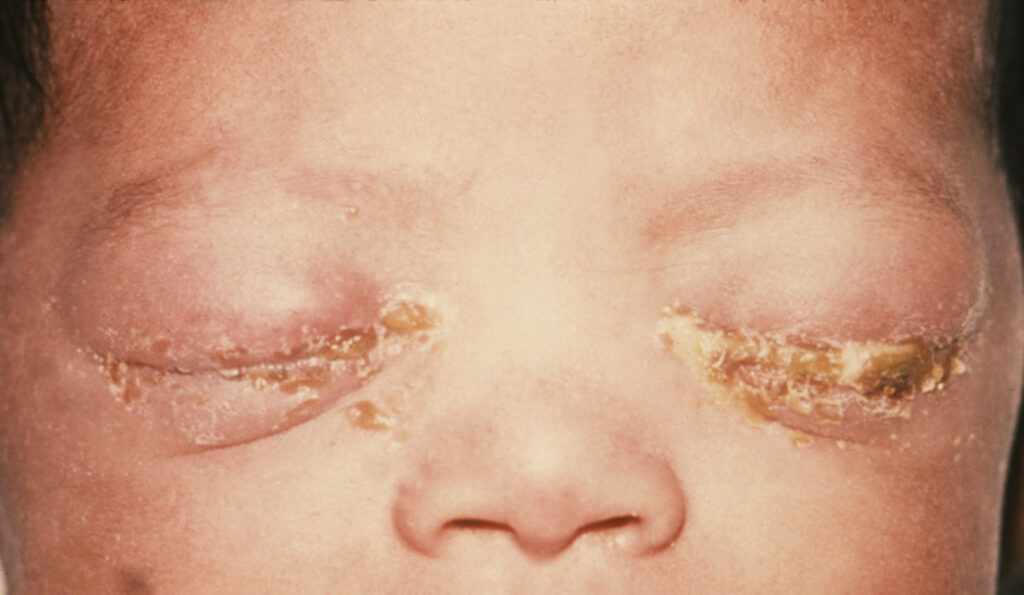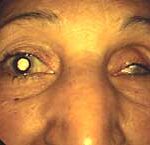Ophthalmia neonatorum, also known as neonatal conjunctivitis, is a form of eye infection occurring within the first 28 days of life. It is characterized by inflammation of the conjunctiva—the clear membrane lining the eyelids and covering the white part of the eyes. This condition demands immediate medical attention due to the risk of corneal damage and potential blindness if left untreated.

Etiology: Common Causes of Ophthalmia Neonatorum
Ophthalmia neonatorum may result from bacterial, viral, or chemical exposure during or shortly after birth. The most common causes include:
1. Neisseria gonorrhoeae (Gonococcal Conjunctivitis)
- Appears 2–5 days after birth
- Causes severe purulent discharge
- High risk of corneal ulceration and perforation
2. Chlamydia trachomatis (Chlamydial Conjunctivitis)
- Onset 5–14 days post-delivery
- Watery to purulent discharge, often with mild eyelid swelling
- May be associated with pneumonia
3. Herpes Simplex Virus (HSV)
- Presents with watery discharge and vesicular skin lesions
- Can involve the cornea and retina
- Risk of systemic spread, including encephalitis
4. Chemical Conjunctivitis
- Often due to prophylactic eye drops (e.g., silver nitrate)
- Appears within 24 hours
- Self-limiting and mild
Pathophysiology of Ophthalmia Neonatorum
Transmission typically occurs during passage through the birth canal if the mother is infected with sexually transmitted infections (STIs). Once pathogens contact the conjunctival surface, they invade epithelial cells, triggering an immune response that leads to redness, discharge, and swelling.
Clinical Presentation: Signs and Symptoms
Onset and Symptom Timing
- Chemical: Within 24 hours
- Gonococcal: 2–5 days
- Chlamydial: 5–14 days
- Herpetic: 6–14 days
Symptoms
- Conjunctival redness
- Eye discharge (watery, mucopurulent, or purulent)
- Eyelid swelling
- Photophobia
- Corneal clouding (in severe cases)
- Vesicles on eyelids (in HSV cases)
Diagnostic Methods for Ophthalmia Neonatorum
Accurate diagnosis is critical for selecting effective treatment and preventing complications.
1. Clinical Examination
- Inspection for discharge, swelling, and corneal clarity
2. Gram Stain and Culture
- Useful for identifying N. gonorrhoeae
3. Giemsa Stain
- Identifies intracellular inclusions characteristic of C. trachomatis
4. PCR (Polymerase Chain Reaction)
- Detects viral DNA (e.g., HSV)
5. Fluorescein Staining
- Assesses corneal epithelial damage
Treatment Protocols for Ophthalmia Neonatorum
Gonococcal Conjunctivitis
- First-line Treatment: Intravenous or intramuscular ceftriaxone
- Topical Therapy: Saline irrigation and erythromycin ointment
- Hospitalization: Recommended for close monitoring
Chlamydial Conjunctivitis
- Oral Erythromycin for 14 days
- Topical Antibiotics as adjuncts
- Evaluation for systemic involvement (e.g., pneumonia)
Herpetic Conjunctivitis
- Systemic Acyclovir therapy
- Topical Antiviral Agents (e.g., trifluridine)
- Monitor for neurological complications
Chemical Conjunctivitis
- No specific treatment required
- Resolves spontaneously with supportive care
Prevention Strategies for Ophthalmia Neonatorum
Universal Prophylaxis at Birth
Administering preventive eye treatment immediately after birth is a global standard practice.
Common Agents:
- Erythromycin ointment (0.5%)
- Tetracycline ointment (1%)
- Povidone-iodine (2.5%) – effective against viruses and bacteria
Maternal Screening and Treatment
- Prenatal screening for gonorrhea and chlamydia
- Timely antibiotic treatment during pregnancy
- Safe delivery practices
Cesarean Section
- Considered if active herpes lesions are present near delivery time
Complications and Long-Term Impact
If left untreated or improperly managed, ophthalmia neonatorum can lead to serious complications:
- Corneal ulceration
- Blindness
- Systemic infections (e.g., sepsis, pneumonia, encephalitis)
- Chronic conjunctivitis
Prompt intervention significantly reduces the risk of vision impairment.
Global Health Perspective
Ophthalmia neonatorum remains a significant public health issue in developing countries where maternal STI screening and newborn prophylaxis are inconsistent. Global initiatives by the WHO and UNICEF emphasize:
- Increasing access to prenatal care
- Ensuring availability of prophylactic agents
- Educating healthcare workers and parents
Frequently Asked Questions:
Q1: Can ophthalmia neonatorum be prevented?
Yes. Through maternal STI screening and neonatal eye prophylaxis.
Q2: Is the condition contagious?
Yes. Especially gonococcal and chlamydial conjunctivitis can spread during delivery.
Q3: How soon should symptoms be reported?
Immediately. Any redness or discharge in a newborn’s eye warrants prompt medical evaluation.
Q4: Can ophthalmia neonatorum recur?
Reinfection can occur if the maternal STI remains untreated.
Q5: Is treatment safe for newborns?
Yes. Antibiotics and antivirals used are neonatally approved and safe under medical supervision.
Ophthalmia neonatorum, though preventable and treatable, poses a serious threat to neonatal ocular health if neglected. Early diagnosis, effective therapy, and stringent preventive strategies—including maternal screening and immediate postpartum eye care—are pivotal in eradicating this condition. As healthcare providers and global stakeholders, we must prioritize timely intervention to safeguard every child’s vision from the moment of birth.

